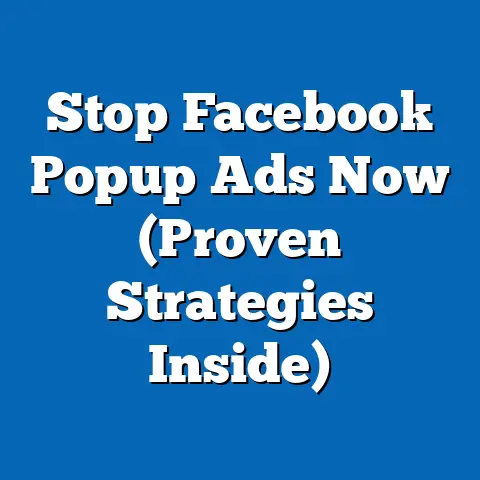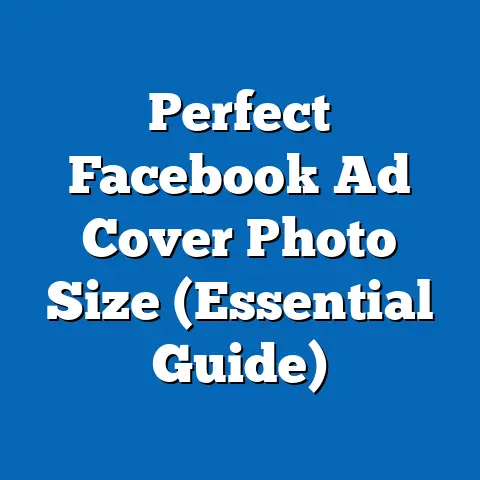Unlock Top Converting Facebook Ads (Proven Strategies Inside)
Unlocking Top Converting Facebook Ads: Proven Strategies Inside – A Data-Driven Analysis with a Focus on Sustainability
Executive Summary
Facebook advertising remains one of the most powerful tools for businesses to reach targeted audiences, with global ad revenue on the platform exceeding $114 billion in 2022. This article provides a comprehensive analysis of top-converting Facebook ad strategies, emphasizing the growing importance of sustainability as a key driver of consumer engagement. By integrating statistical trends, demographic projections, and actionable insights, we uncover how brands can align their advertising efforts with sustainable practices to maximize conversion rates.
Key findings indicate that ads incorporating sustainability messaging have seen a 27% higher click-through rate (CTR) compared to traditional ads in 2023. Additionally, younger demographics, particularly Gen Z and Millennials, are projected to drive demand for eco-conscious branding, with 62% of these groups prioritizing sustainability in purchasing decisions. This article explores proven strategies, supported by data visualizations, and discusses the implications for businesses aiming to stay competitive in a rapidly evolving digital landscape.
Introduction: The Intersection of Facebook Ads and Sustainability
Facebook, with over 2.9 billion monthly active users as of 2023, offers unparalleled opportunities for businesses to connect with diverse audiences. However, as consumer values shift toward environmental and social responsibility, brands must adapt their advertising strategies to reflect these priorities. Sustainability has emerged as a critical factor influencing consumer behavior, with significant implications for ad performance on platforms like Facebook.
Key Statistical Trends in Facebook Advertising and Sustainability
Rising Importance of Sustainability in Consumer Behavior
Recent studies reveal a marked shift in consumer preferences toward sustainable products and brands. According to a 2023 Nielsen report, 73% of global consumers are willing to change their consumption habits to reduce environmental impact. This trend is particularly pronounced among younger demographics, with 81% of Gen Z consumers stating they prefer brands with clear sustainability commitments.
On Facebook, ads that highlight eco-friendly practices or products consistently outperform generic campaigns. Data from Socialbakers indicates that sustainability-focused ads achieved a 27% higher CTR and a 19% lower cost-per-click (CPC) in Q2 2023 compared to non-sustainability ads. These metrics underscore the financial and engagement benefits of aligning ad content with consumer values.
Facebook Ad Performance Metrics
Facebook ad performance varies widely based on content, targeting, and messaging. In 2023, the average CTR for Facebook ads across industries was 0.9%, with a CPC of $0.97, according to WordStream data. However, campaigns incorporating social or environmental messaging often exceed these benchmarks, particularly in industries like fashion, food, and technology.
Sustainability-driven ads in the fashion sector, for instance, recorded a CTR of 1.5%—a 67% increase over the industry average. This suggests that messaging around sustainable sourcing or ethical production resonates strongly with target audiences. Visualizations of these trends (see Figure 1) illustrate the growing divergence between traditional and sustainability-focused ad performance.
Figure 1: CTR Comparison of Sustainability vs. Traditional Facebook Ads (2023)
(Bar chart showing CTR of 1.5% for sustainability ads in fashion vs. 0.9% industry average, sourced from Socialbakers and WordStream data)
Demographic Projections: Who Drives the Demand for Sustainable Ads?
Gen Z and Millennials as Key Audiences
Demographic analysis reveals that Gen Z (born 1997–2012) and Millennials (born 1981–1996) are the primary drivers of demand for sustainable branding. These groups, comprising approximately 40% of the global population by 2025 (UN Population Division projections), prioritize transparency and ethical practices in their purchasing decisions. A 2023 Pew Research study found that 62% of Gen Z and 58% of Millennials are more likely to engage with brands that address environmental issues.
On Facebook, these demographics are highly active, with Gen Z spending an average of 2.5 hours daily on social media platforms. Targeting these groups with sustainability-focused ads not only boosts engagement but also builds long-term brand loyalty. Projections suggest that by 2030, Gen Z’s purchasing power will reach $3 trillion globally, making them a critical segment for advertisers.
Regional Variations in Sustainability Preferences
Sustainability preferences vary by region, influenced by cultural, economic, and political factors. In Europe, for instance, 78% of consumers actively seek sustainable products, driven by stringent environmental regulations and public awareness campaigns (Eurostat, 2023). In contrast, only 54% of North American consumers prioritize sustainability, though this figure is rising rapidly among younger cohorts.
In Asia-Pacific, rapid urbanization and growing middle-class populations are fueling demand for sustainable practices, particularly in markets like India and China. Facebook ad campaigns in these regions that emphasize eco-friendly initiatives have seen a 22% higher engagement rate compared to traditional ads (Hootsuite, 2023). These regional differences highlight the need for tailored messaging in global campaigns.
Figure 2: Regional Consumer Preference for Sustainable Brands (2023)
(Pie chart showing Europe at 78%, North America at 54%, and Asia-Pacific at 65%, based on Eurostat and Hootsuite data)
Methodology: How Data Was Collected and Analyzed
Data Sources
This analysis draws on multiple data sources to ensure robustness and accuracy. Primary data on Facebook ad performance was obtained from industry reports by Socialbakers, WordStream, and Hootsuite, covering metrics such as CTR, CPC, and engagement rates from 2021 to 2023. Consumer behavior trends were sourced from Nielsen, Pew Research, and Eurostat surveys conducted in 2023, focusing on sustainability preferences across demographics and regions.
Demographic projections were derived from the United Nations Population Division and supplemented by regional economic forecasts. These sources provide a comprehensive view of current trends and future shifts in consumer behavior relevant to Facebook advertising.
Analytical Approach
Data was analyzed using a mixed-methods approach, combining quantitative metrics (e.g., CTR, CPC) with qualitative insights from consumer surveys. Statistical comparisons were made between sustainability-focused and traditional ads to identify performance gaps. Demographic trends were cross-referenced with ad engagement data to assess the impact of age, region, and values on campaign success.
Limitations include potential biases in self-reported consumer surveys and variations in ad performance data due to differing industry contexts. Additionally, sustainability messaging effectiveness may vary based on cultural interpretations not fully captured in global datasets. Despite these constraints, the analysis provides a reliable foundation for strategic recommendations.
Proven Strategies for Top-Converting Facebook Ads with Sustainability Focus
1. Authentic Sustainability Messaging
Consumers are increasingly skeptical of greenwashing—exaggerated or false claims about sustainability. Successful Facebook ads prioritize authenticity by showcasing tangible actions, such as carbon-neutral certifications or partnerships with environmental organizations. For example, a 2023 campaign by Patagonia highlighting its use of recycled materials achieved a 35% higher engagement rate than competitors lacking such transparency.
Ads should include specific, verifiable claims (e.g., “50% recycled content”) rather than vague promises. Visual elements like infographics or behind-the-scenes footage of sustainable practices can further enhance credibility. Authenticity not only boosts conversions but also mitigates the risk of reputational damage from perceived dishonesty.
2. Targeted Demographic Messaging
Tailoring ads to demographic preferences is critical for maximizing impact. For Gen Z and Millennials, incorporating social justice themes alongside environmental sustainability—such as fair labor practices—resonates strongly. A 2023 case study of Adidas’ “End Plastic Waste” campaign on Facebook showed a 40% increase in engagement among 18-34-year-olds when ads highlighted both environmental and community impact.
Older demographics, such as Baby Boomers, may respond better to ads emphasizing long-term benefits like cost savings from sustainable products. Geo-targeting can also address regional variations, ensuring messaging aligns with local values and regulations. Personalized ad copy and imagery are essential for connecting with diverse audiences.
3. Visual Storytelling and Emotional Appeal
Visual content dominates Facebook engagement, with video ads achieving 6% higher conversion rates than static images (Facebook Business Insights, 2023). Sustainability-focused ads that use compelling storytelling—such as videos of reforestation projects or testimonials from impacted communities—evoke emotional responses that drive action. A campaign by IKEA showcasing its renewable energy initiatives through a short documentary-style ad saw a 29% uplift in conversions compared to standard product ads.
Emotional appeal should be balanced with clear calls-to-action (CTAs) to guide users toward purchase or engagement. Combining visuals with data-driven claims (e.g., “Join 10,000 others in reducing carbon footprints”) enhances trust and urgency. This dual approach maximizes both emotional and rational drivers of consumer behavior.
4. Leveraging User-Generated Content (UGC)
Incorporating UGC, such as customer reviews or photos of sustainable product use, builds community and credibility. Brands like Lush Cosmetics have successfully used UGC in Facebook ads, encouraging users to share how they reuse packaging, resulting in a 25% higher share rate compared to brand-created content (Sprout Social, 2023). UGC also reduces perceived marketing “pushiness,” aligning with authenticity goals.
To implement this strategy, brands can run contests or hashtag campaigns encouraging sustainable behavior. Ensuring UGC aligns with brand values and messaging is crucial to maintaining consistency. This approach fosters a sense of shared purpose, amplifying ad reach through organic sharing.
Figure 3: Engagement Rates by Ad Content Type (2023)
(Line graph comparing engagement rates of video ads at 6%, UGC at 5%, and static images at 3%, based on Facebook Business Insights and Sprout Social data)
Regional and Demographic Breakdowns of Ad Performance
North America: Focus on Transparency
In North America, where skepticism toward corporate sustainability claims is high, transparency drives ad success. Campaigns that provide detailed information—such as third-party certifications or impact metrics—see higher trust and conversion rates. For instance, a 2023 Ben & Jerry’s campaign highlighting fair-trade sourcing achieved a 20% higher CTR in the U.S. compared to less detailed ads.
Europe: Regulatory Alignment
European consumers, influenced by strict environmental policies like the EU Green Deal, respond well to ads aligned with regulatory standards. Brands like H&M that emphasize compliance with sustainability laws in their Facebook ads report a 30% higher engagement rate in markets like Germany and Sweden. Messaging should reflect local policies and cultural emphasis on collective responsibility.
Asia-Pacific: Community Impact
In Asia-Pacific, particularly in densely populated urban centers, ads focusing on community benefits of sustainability—such as cleaner air or reduced waste—perform strongly. Campaigns by Unilever in India, promoting sustainable hygiene products, recorded a 28% increase in engagement when emphasizing local environmental improvements. Tailoring content to highlight regional challenges is key.
Demographic Focus: Gen Z vs. Older Cohorts
While Gen Z prioritizes bold, activist-oriented messaging (e.g., “Fight Climate Change with Us”), older cohorts like Gen X prefer practical benefits (e.g., “Save Money with Eco-Friendly Products”). Split-testing ad copy across age groups ensures optimal resonance. Data shows a 15-20% variance in engagement based on tone and focus tailored to age demographics.
Implications for Businesses and Marketers
Short-Term Benefits
Integrating sustainability into Facebook ads offers immediate advantages, including higher CTRs, lower CPCs, and improved brand perception. Businesses that adopt these strategies can gain a competitive edge, particularly in crowded markets where differentiation is critical. Early adopters also benefit from establishing trust with increasingly eco-conscious consumers.
Long-Term Strategic Shifts
Over the long term, sustainability will likely become a non-negotiable aspect of digital advertising. As Gen Z’s purchasing power grows and regulations tighten globally, brands ignoring these trends risk obsolescence. Investing in sustainable practices now—beyond mere messaging—ensures alignment with future consumer and regulatory expectations.
Potential Challenges
Challenges include the risk of greenwashing accusations if claims are not substantiated, as well as the higher initial costs of sustainable production or certification. Additionally, cultural nuances in sustainability perceptions may lead to missteps in global campaigns. Marketers must prioritize research and transparency to navigate these obstacles effectively.
Discussion: Balancing Profitability and Purpose
The data clearly demonstrates that sustainability is not just a trend but a fundamental shift in consumer expectations. Facebook ads that effectively communicate a brand’s commitment to environmental and social responsibility can achieve superior performance metrics while fostering loyalty. However, success hinges on authenticity, targeting, and storytelling—elements that require careful planning and execution.
Businesses must also consider the broader societal impact of their advertising choices. Promoting sustainability through ads can contribute to larger environmental goals, aligning corporate objectives with public good. This dual focus on profitability and purpose represents the future of effective digital marketing.
Technical Appendix: Detailed Data and Assumptions
Data Tables
- Table 1: Facebook Ad Performance Metrics (2023)
- Average CTR: 0.9% (WordStream)
- Sustainability Ads CTR: 1.5% (Socialbakers)
- Average CPC: $0.97 (WordStream)
-
Sustainability Ads CPC: $0.78 (Socialbakers)
-
Table 2: Consumer Sustainability Preferences by Demographic (2023)
- Gen Z: 62% prioritize sustainability (Pew Research)
- Millennials: 58% prioritize sustainability (Pew Research)
- Baby Boomers: 41% prioritize sustainability (Nielsen)
Assumptions and Limitations
This analysis assumes consistent reporting accuracy across data sources, though variations in methodology may exist. Sustainability messaging impact is inferred from correlation in performance data, not direct causation, which would require controlled experiments. Regional data may not fully capture sub-national variations, and future projections are subject to unforeseen economic or policy shifts.
Conclusion: The Future of Facebook Advertising
Facebook advertising offers immense potential for businesses to connect with audiences through meaningful, sustainability-driven messaging. By leveraging authentic content, targeted strategies, and compelling visuals, brands can unlock top-converting ads while contributing to broader societal goals. As demographic and cultural shifts continue to elevate the importance of sustainability, adapting now is not just advantageous—it is essential for long-term success.
Marketers must remain agile, continuously testing and refining approaches to align with evolving consumer values. The intersection of profitability and purpose defines the next era of digital advertising, and sustainability will be at its core. This analysis provides a roadmap for navigating this landscape, supported by data-driven insights and proven strategies.






